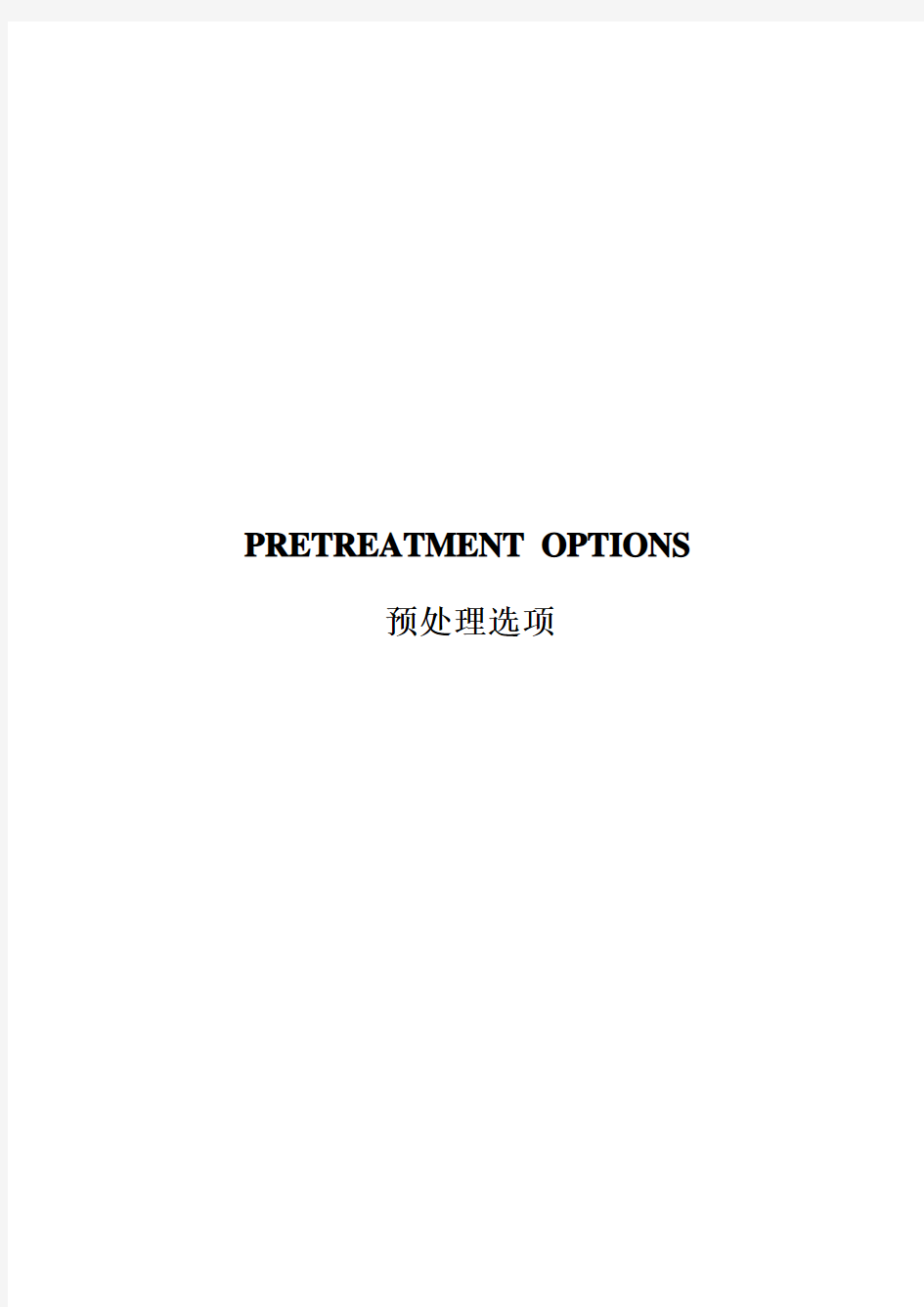
ISPE 4.预处理选项
- 格式:doc
- 大小:136.00 KB
- 文档页数:20


PRETREATMENT OPTIONS
预处理选项
4. PRETREATMENT OPTIONS 预处理选项
4.1 INTRODUCTION 简介
Pretreatment is all process steps or unit operations prior to the last (final) water treatment step. Pretreatment is a series of unit operations to modify the feed water quality so that it will be of adequate quality to be fed to a final treatment step. This final step may be Reverse Osmosis, Ultrafiltration, Multi or Mixed Bed Deionization or Distillation. These final steps are discussed in Chapters 5 and 6.
预处理是指最后(最终)水处理步骤之前的所有加工步骤或单元操作。预处理是一系列的单元操作,用来改善给水水质以使其水质足够好而进入终处理步骤。最终步骤可以是反渗透、超滤、多或混合床去离子或蒸馏。第5、6章中将详细讨论这些最终步骤。
Reverse Osmosis is unique since it can be a pretreatment step, in addition to being a final treatment step.Reverse Osmosis applications in pretreatment are discussed in this chapter and Chapter 11, but Reverse Osmosis as a technology is discussed in Chapters 5 and 6.
反渗透很特别,因为它即可以是一个预处理步骤,另外还能是一个终处理步骤。本章和第11章将讨论反渗透作为预处理的情况,而将其作为一门技术的情况将在5、6章中详述。
The initial sections of this chapter discuss the process design (programming issues) for pretreatment design including feed water quality and output water quality from pretreatment. The chapter then discusses the selection of treatment options (i.e. unit operations) for four groups of impurities:
本章的开始部分讨论预处理设计的过程设计(程序设计问题),包括给水水质和经过预处理后出来的水质。然后讨论针对四种杂质所做选择的处理选项(即单元操作):
• Control of fouling-removal of turbidity and particulates
浑浊度和粒子的除垢控制
• Control of scaling-removal of hardness and metals
硬度和金属的除氧化皮控制
• Removal of organics and microbiological impurities
有机物和微生物杂质的去除
• Removal of microbial control agents
微生物防治因子的去除
Pre-treatment options are summarized in Figure 4-1 at the end of the chapter.
本章结尾处的图4-1中总结了预处理的可选方案。
The final sections of the chapter discuss the importance of anion composition/concentration, pH, materials of construction, and pretreatment system control.
本章的最后讨论了阳离子的构成/深度、pH、组成材料以及预处理系统控制的重要性。This discussion is based on the description of these technologies presented in Chapter 11.
这些讨论是建立在11章中出现的对这些技术的叙述基础之上的。
4.2 PROCESS DESIGN OF PRETREATMENT预处理的过程设计
Process design of the pretreatment system is the specification of the unit operations or process steps to treat the feed water. Typical information includes flow rates, temperatures, pressure, and composition of all streams. Detailed mechanical design of the equipment for a given unit operation or process step is beyond the scope of this Guide.
预处理系统的过程设计是对处理给水的单元操作或加工步骤的规范。典型信息包括流速、温度、压力以及所有水流的组合。为给出的单元操作或加工步骤的设备做详细的机械设计不在此指南范围内。
The process design (programming issues) for a pretreatment system may include:
预处理系统的过程设计(程序设计问题)可能包括:
a) Required quantity and quality of the water from the final treatment process.
经过终处理程序出来的必须的水量和水质。
b) Temperature constraints on the water used in a pharmaceutical process and the approach to
microbial control.
对用于制药工艺的水温和防治微生物所需的温度限制。
c) The final treatment option that has been chosen, as this defines the required water quality
leaving pre-treatment.
已经选定的终处理选项,这就规定了离开了预处理步骤所需达到的水质。
d) Quality of the feed water that is the input to the pretreatment system (water quality to be
validated over a one year period).
预处理系统的给水水质(验证水质需要一年以上的期限)
e) Difference between input water quality and desired output water quality. The difference
determines imprities that must be removed by the pretreatment system. The difference is determined by performing a material balance. Attention should be paid to impurities and minor components.
输入水水质和希望得到的输出水水质之间的差异。此差异确定了必须要用预处理系统去除的杂质。此差异是通过执行一个物料平衡来决定的。应当特别注意杂质和较小的组分。
f)Pretreatment options to provide the desired removal of impurities considering other factors
such as capabilities of the labor force, economics, waste disposal, environmental considerations, validation, and the available space and utilities.